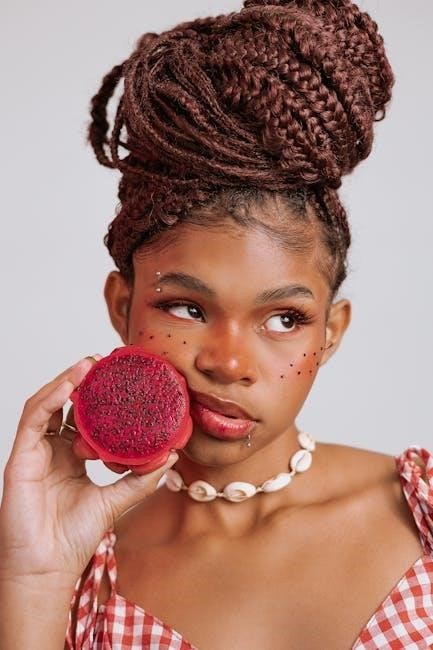Nostril piercing is a popular and timeless form of facial piercing, combining elegance and boldness. Originating in 16th-century India, it has become a preferred choice for personal expression.
1.1 What is a Nostril Piercing?
A nostril piercing is a facial piercing located on the soft tissue of the nasal nostril. It involves creating a small hole in the nostril, typically on one side, though double piercings on both nostrils are also popular. This piercing is a form of body modification that combines cultural significance with aesthetic appeal, making it a timeless choice for self-expression. It is often adorned with various types of jewelry, enhancing its visual appeal and personal style.
1.2 History and Cultural Significance
Nostril piercings have a rich history rooted in ancient cultures, particularly in India, where they symbolized marital status and spiritual significance. The practice spread across the Middle East and Africa, often representing cultural identity and beauty. In Western societies, nostril piercings gained popularity in the 1960s as a symbol of rebellion and individuality. Today, they are a global phenomenon, blending traditional meanings with modern self-expression, making them a cherished form of body art across diverse cultures.
1.3 Popularity and Timelessness
Nostril piercings remain highly popular due to their versatility and timeless appeal. They are second only to ear piercings in popularity, favored for their elegance and boldness; This piercing suits various styles, from subtle to statement-making, and complements diverse facial features. Its enduring appeal stems from its ability to adapt to changing fashion trends while maintaining a classic look. Whether for aesthetic or cultural reasons, nostril piercings continue to be a preferred choice for self-expression and personal style.
Types and Placements of Nostril Piercings
Nostril piercings offer various styles, including single, double, high nostril, mantis, and nasallang. Each placement provides a unique aesthetic, catering to different preferences and anatomies, ensuring a personalized look.
2.1 Single Nostril Piercing
The single nostril piercing is a classic and popular choice, involving one piercing on either the left or right nostril. It is versatile, complementing various facial features and personal styles. This piercing is often positioned at the crease of the nostril, creating a subtle yet elegant look. Many opt for this style due to its timeless appeal and ease of pairing with different jewelry types, such as studs or hoops, making it suitable for both minimalistic and bold aesthetics.
2.2 Double Nostril Piercing
The double nostril piercing is a striking variation featuring two piercings on each nostril, creating a bold and eye-catching look. This style allows for creative expression, with options for symmetric or asymmetric placements. Many opt for high nostril placements, while others prefer lower positions for a more subtle appearance. Jewelry choices include studs, hoops, or seamless rings, offering versatility to suit individual styles. This piercing is ideal for those seeking a distinctive aesthetic and a way to showcase their personality through unique jewelry combinations.
2.3 High Nostril Piercing
The high nostril piercing is a stylish variation placed higher up on the nostril, creating a striking yet elegant look. It is often favored for its versatility, as it complements various face shapes and personal styles. This piercing is ideal for those seeking a subtle yet noticeable aesthetic. Jewelry options include small studs, hoops, or delicate rings, allowing for a range of expressions. Its higher placement makes it a great choice for those who want a unique twist on the classic nostril piercing while maintaining a sophisticated appearance.
2.4 Mantis Piercing
The mantis piercing offers a unique aesthetic with two piercings on one nostril, creating a bold and eye-catching look. This style involves placing two separate piercings close together, often with a small gap in between. It allows for creative jewelry combinations, such as pairing studs with hoops or rings. The mantis piercing is perfect for those who want to stand out, offering a striking and asymmetrical appearance. Proper aftercare is essential for healing, as the dual piercings require careful maintenance to ensure quick recovery and prevent complications.
2.5 Nasallang Piercing
The nasallang piercing is a bold and striking option, involving three piercings in one nostril. It starts at the entrance of the nostril, goes through the septum, and exits on the other side. This piercing is ideal for those who want a dramatic and unique look. Jewelry options include straight bars or decorative pieces. Healing times are longer due to the complexity of the piercing, requiring diligent aftercare to prevent complications. Proper hygiene and professional guidance are essential for a successful nasallang piercing experience.

Choosing the Right Jewelry for Your Nostril Piercing
Quality jewelry is vital for a successful piercing. Opt for implant-grade materials like 18k gold, titanium, or stainless steel to ensure comfort and minimize allergic reactions.
3.1 Types of Jewelry
Common types of nostril jewelry include straight posts, nose bones, and rings. Straight posts are simple and secure, while nose bones feature a ball for added stability. Rings offer a decorative option. Each style caters to different preferences, ensuring a personalized look. Choose jewelry that complements your anatomy and lifestyle for optimal comfort and aesthetics.
3.2 Recommended Materials
For nostril piercings, high-quality materials are essential for safe healing and comfort. 14k or 18k gold, implant-grade titanium, and surgical stainless steel are recommended due to their hypoallergenic properties. These materials minimize the risk of allergic reactions and promote optimal healing. Avoid low-quality metals like brass or plastic, as they can cause irritation or infections. Choosing the right material ensures a smooth recovery and long-term satisfaction with your piercing.
3.3 Size and Fit Considerations
Choosing the correct size and fit for your nostril piercing is crucial for comfort and aesthetics. The jewelry should snugly fit your anatomy without being too tight or loose. Consider the thickness of your nostril and the desired appearance when selecting the size. Proper fit ensures healing and prevents irritation. A professional piercer can help determine the ideal size based on your nose shape and personal style for optimal comfort and visual appeal.

The Piercing Procedure
The procedure involves marking the spot, using a sterile needle, and securing jewelry. A professional ensures precision, safety, and comfort throughout the process for optimal results.
4.1 Initial Consultation
The initial consultation is crucial for discussing expectations and practical details. Your piercer will guide you on jewelry selection, ensuring high-quality materials like 18k gold or implant-grade titanium. They will also explain the procedure, address any concerns, and outline aftercare guidelines. This step ensures a personalized experience, focusing on your anatomy and style preferences. The consultation sets the foundation for a safe and successful piercing process, helping you feel prepared and confident.
4.2 Marking and Preparation
Marking and preparation are essential steps before the piercing. Your piercer uses a sterile marker to precisely mark the desired location, ensuring symmetry and alignment with your anatomy. The area is thoroughly cleaned to remove bacteria and reduce infection risks. Jewelry is prepared, and a sterile needle of the appropriate gauge is selected. This meticulous preparation ensures accuracy and safety, setting the stage for a smooth piercing process. Attention to detail during this phase is critical for optimal results.
4.3 The Piercing Process
The piercing process begins with the piercer accurately inserting a sterile needle through the marked area of the nostril. The client is often asked to take a deep breath to relax. The needle is quickly passed through the skin, and the jewelry is securely attached. This step is brief, with the actual piercing causing temporary discomfort. Professional piercers ensure precision and care to make the experience as smooth as possible, minimizing pain and ensuring proper placement for optimal healing.
4.4 Securing the Jewelry
After the needle passes through, the piercer carefully attaches the chosen jewelry, ensuring it is securely fastened. High-quality materials like implant-grade titanium, stainless steel, or 18k gold are recommended for better healing. Jewelry options include nose bones or screws, designed with a ball or bump to prevent falling out. The piercer ensures proper fit and comfort, avoiding tightness that could irritate the area. Proper jewelry maintenance and adherence to aftercare guidelines are essential for a smooth recovery and to prevent complications.
Pain and Discomfort
Nostril piercing pain is moderate, rated 4-5/10. Temporary stinging or pressure is normal. Individual sensitivity and piercing technique influence discomfort. Numbing creams can help reduce pain.
5.1 Pain Level and Expectations
The pain level for a nostril piercing is typically moderate, often rated between 4 to 5 on a 10-point scale. Most individuals describe the sensation as a brief stinging or pressure during the needle insertion. The discomfort is temporary and manageable for most people. Factors such as individual pain sensitivity, the specific location of the piercing, and the piercer’s technique can influence the experience. Overall, the pain is manageable, and the end result is often considered well worth it by those who choose to get a nostril piercing.
5.2 Tips for Reducing Pain
To minimize discomfort during a nostril piercing, consider using a lidocaine-based numbing cream like EMLA, applied 30-60 minutes prior to the procedure. Staying relaxed and breathing deeply can also help manage anxiety. Ensuring you’re well-rested and hydrated beforehand may reduce sensitivity. Avoid stress or intense activities before the piercing, as these can heighten pain perception. Lastly, trust your professional piercer, as their expertise and technique will make the process smoother and less painful.
5.3 Individual Pain Sensitivity
Pain sensitivity varies significantly among individuals, influencing the nostril piercing experience. Factors like personal tolerance, skin thickness, and piercing location can affect discomfort levels. While some describe the pain as mild, others find it more intense. The piercing process itself, though quick, involves a stinging sensation as the needle passes through the nostril tissue. Individual differences in nervous system response and anxiety levels also play a role in how pain is perceived during the procedure.
Healing Process and Aftercare
The nostril piercing heals in 4-6 months, with swelling and crust formation common. Proper aftercare includes saline cleaning, avoiding irritants, and refraining from jewelry changes during healing.
6.1 Cleaning Instructions
Proper cleaning is essential for healing. Gently clean the piercing twice daily with mild soap and warm water or a sterile saline solution. Avoid alcohol or iodine. Do not touch the piercing with unclean hands. After cleaning, pat dry with a clean towel. Refrain from rubbing or scratching, as this can delay healing. Avoid swimming in pools or hot tubs during healing. If infection signs appear, seek professional help immediately.
6.2 Healing Timeline
The healing process for a nostril piercing typically ranges from 4 to 6 months. Initial swelling, redness, and sensitivity are normal in the first few weeks. A light crust may form, but avoid removing it as it aids healing. Keep the area clean and avoid jewelry changes during this period. Proper aftercare is crucial to prevent complications. Healing time varies based on individual health and adherence to care guidelines. Monitor progress and consult a professional if issues arise.
6.3 Common Healing Issues
Common issues during nostril piercing healing include infections, allergic reactions, and delayed healing. Infections may cause redness, swelling, or discharge, often due to poor hygiene or low-quality jewelry. Allergic reactions to metals like nickel can occur, emphasizing the importance of high-quality materials. Additionally, keloids or granulomas may form in some individuals. Proper aftercare, such as avoiding irritants and keeping the area clean, can prevent many of these issues. If complications arise, consult a professional for guidance and treatment to ensure proper healing.

Cost of Nostril Piercings
Nostril piercings typically cost between $35 to $50 in reputable shops. The price varies based on the piercer’s expertise and studio reputation, with jewelry costs being a major factor.
7.1 Price Range
Nostril piercings typically range from $35 to $50 in reputable studios. This cost generally covers the piercing procedure itself, with jewelry costs added separately. Higher prices often reflect expertise, hygiene standards, and studio reputation. While initial costs may seem modest, investing in quality jewelry and professional service ensures a safer, more satisfactory experience. Prices can vary based on location and studio prestige, but prioritizing quality is essential for long-term satisfaction and health.
7.2 Factors Affecting Cost
The cost of a nostril piercing can vary based on several factors, including location, piercer expertise, and studio reputation. Studios in urban areas often charge more due to higher operational costs. Additionally, the experience and qualifications of the piercer can influence pricing, with skilled professionals typically charging higher rates. Jewelry costs also play a significant role, as high-quality materials like 14K/18K gold or implant-grade titanium are more expensive. Some studios may offer package deals, which can affect the overall price.
7.3 Jewelry Costs
Jewelry costs for nostril piercings vary widely, depending on the material and design. Basic pieces, like straight posts or nose bones, start around $10-$30, while high-quality options in 18k gold or gemstones can range from $50 to $200 or more. The initial jewelry is often included in the piercing fee, but upgrading to premium styles may incur additional costs. The material quality, craftsmanship, and brand reputation significantly influence the final price of the jewelry.
Maintaining Your Nostril Piercing
Regular cleaning with saline solution and avoiding harsh products helps maintain your piercing. Check jewelry fittings periodically and consult professionals for any adjustments or concerns.
8.1 Long-Term Care
Proper long-term care ensures your nostril piercing remains healthy and visually appealing. Clean the area regularly with saline solution to prevent buildup and irritation. Avoid using harsh chemicals or fragrances that may cause allergic reactions. Periodically inspect the jewelry for tightness or wear and tear. If you notice any issues, consult a professional for adjustments. Regularly washing your hands before touching the piercing is essential to maintain hygiene. By following these practices, you can enjoy your piercing for years without complications.
8.2 Jewelry Maintenance
Regular jewelry maintenance is crucial for the health and appearance of your nostril piercing. Clean your jewelry with saline solution to remove dirt and buildup. Avoid using harsh chemicals or fragrances that may damage the material. For metal jewelry, periodic polishing can restore its shine. Inspect your jewelry regularly for signs of wear, such as loose threads or discoloration. If you notice any issues, consult a professional piercer for adjustments or replacements to ensure your piercing remains secure and visually appealing.
8.3 When to Change Jewelry
Change your jewelry once the piercing is fully healed, typically after 4-6 months. If you experience discomfort or notice jewelry damage, consult a professional piercer immediately. Avoid changing jewelry during the healing process unless necessary, as this can irritate the piercing. When switching jewelry, ensure the new piece is made from high-quality, hypoallergenic materials. Always seek professional guidance to avoid complications and maintain the health of your nostril piercing.

Potential Risks and Complications
Nostril piercings carry risks like infections, allergic reactions, or improper healing. Ensure proper aftercare and use high-quality jewelry to minimize complications and promote a safe recovery process.
9.1 Infection Risks
Infection is a primary risk with nostril piercings, often caused by improper aftercare. Clean the area regularly with saline solution and avoid alcohol-based products. Keep the piercing dry and avoid touching it with unclean hands. Refrain from swimming in public pools during healing. Additionally, choosing high-quality jewelry can minimize irritation and reduce infection risks. Always follow your piercer’s instructions to ensure proper healing. If signs like redness, swelling, or discharge appear, seek professional help immediately.
9.2 Allergic Reactions
Allergic reactions to jewelry materials are a potential risk with nostril piercings. Nickel is a common allergen, so opt for high-quality, hypoallergenic metals like surgical stainless steel, titanium, or 14k/18k gold. Symptoms include itching, redness, and swelling. If a reaction occurs, remove the jewelry immediately and replace it with a hypoallergenic option. Consulting a professional piercer can help identify suitable materials and prevent allergic responses. Always prioritize jewelry quality to ensure a safe and successful piercing experience.
9.3 Other Possible Complications
Beyond infections and allergies, other complications can arise, such as keloid formation or granulomas. These are benign growths caused by overactive healing. Improper jewelry fit or excessive irritation can lead to these issues. Additionally, if the piercing is not done correctly, it may result in unevenness or scarring. Regular monitoring and adherence to aftercare routines can minimize these risks. If complications persist, consulting a healthcare professional or experienced piercer is essential for timely resolution.
Nostril piercings are a timeless and versatile form of self-expression, blending cultural significance with modern aesthetics. Whether for personal style or symbolic meaning, they offer a unique way to enhance one’s appearance. With proper care and professional guidance, a nostril piercing can be a safe and rewarding experience. Remember, patience during the healing process and adherence to aftercare routines are key to enjoying your piercing for years to come. Embrace this classic choice and let your individuality shine!





